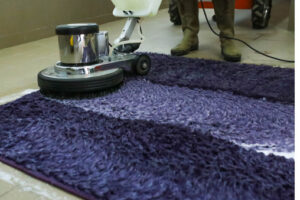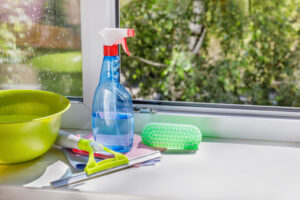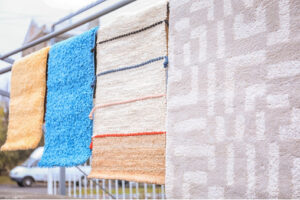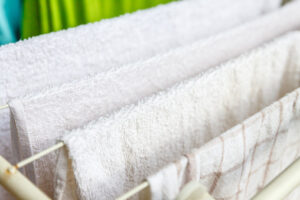Do you have a rug that needs to be cleaned? Maybe you’ve tried pressure washing it and now you don’t know what the next step is. Pressure washing a rug can be an effective way of cleaning, but if not done correctly, it can do more damage than good. Don’t worry – we’ll show you how to dry a rug after pressure washing for best results.
The first step is understanding why proper drying is so important. When moisture remains in the fibers of your rug, it can cause mold and mildew to form, leading to unpleasant odors and even further damage. Knowing how long it takes for your rug to dry will help prevent these issues from arising.
Finally, we’ll provide helpful tips and tricks for making sure your rug dries as quickly as possible without sacrificing its quality or longevity. With our guide on how to dry a rug after pressure washing, you’ll have your beautiful carpet looking like new again in no time!
Overview Of Pressure Washing A Rug
 Pressure washing a rug is a great way to keep it looking its best for longer. It can help to remove dirt and debris that vacuuming alone won’t get rid of, leaving the rug feeling softer and looking brighter. If you’re considering pressure washing your rug, it’s important to know the basics of how to do it efficiently and safely.
Pressure washing a rug is a great way to keep it looking its best for longer. It can help to remove dirt and debris that vacuuming alone won’t get rid of, leaving the rug feeling softer and looking brighter. If you’re considering pressure washing your rug, it’s important to know the basics of how to do it efficiently and safely.
Fortunately, hiring a professional house cleaning or carpet cleaning service can make this process much easier. Not only will they have the right equipment, but they’ll also be able to advise on any specific needs your rug may have. They can also help you decide if pressure washing is the best option for your particular situation.
No matter what method you choose, drying a rug after pressure washing is essential in order to ensure that no damage has been caused by the water and detergent used during the process. Properly drying the rug will also help prevent mold and mildew growth.
Pre-Cleaning Preparation
Before you begin pressure washing a rug, it’s important to do some preparation. First, make sure that the area is well-ventilated and that you have plenty of room to work in. This will help to reduce the risk of any detergent or water splashing onto nearby surfaces. Also, be sure to use an appropriate detergent for your specific type of rug.
It’s also a good idea to test a small area of the rug before starting the pressure washing process. This will help determine if there are any colors that could run or fade due to the water or detergent. Once you’re confident with what you’re doing, it’s time to start pressure washing the rug.
When finished, it’s essential to properly dry the rug so that no damage is caused by moisture or cleaning products. The best way to do this is by using fans and dehumidifiers in order to speed up evaporation and prevent mold growth. If possible, open windows and doors as well for increased air circulation. Additionally, try fluffing up any areas where the rug may have been flattened under the water pressure during cleaning. By taking these steps and following proper drying techniques, you can ensure your rug looks great for years to come!
Pressure Washing Equipment Selection
It’s important to choose the right equipment when pressure washing a rug. The most common tool used is a pressure washer, but there are other options available as well. Depending on the size and type of rug, you may also need brushes and scrubbing pads for tougher stains. It’s important to select the correct nozzle for the job at hand, as different nozzles will create different results. Additionally, it’s best to choose detergents that are specifically designed for use with rugs in order to avoid damage.
Once all of the necessary equipment is gathered, you can begin pressure washing your rug. Make sure to keep a close eye on how much water is being used and be sure not to spray too hard or too close to delicate fabrics. After completing the pressure washing process, it’s time to move on to drying your rug properly in order to avoid any potential damage from moisture or cleaning products.
How To Set Up The Pressure Washer
Setting up the pressure washer correctly is essential to getting the desired results. Begin by connecting the power source and turn on the machine to make sure it’s working properly. Then, attach the nozzle of choice and adjust the pressure setting as required for your specific rug. If you have a brush attachment, attach that now and make sure it is securely in place. Finally, add a detergent or cleaning solution to the tank if needed and be sure not to overfill it.
Now that your pressure washer is ready to go, you can begin pressure washing your rug. Make sure to keep both hands on the nozzle at all times and don’t spray too hard or too close to delicate fabrics. When you’re finished with one section of the rug, move onto another part until you’ve covered all areas with pressurised water and detergent. Once this step is complete, it’s time to move onto drying your rug properly in order to avoid any potential damage from moisture or cleaning products.
Applying The Cleaning Solution
 Once your rug has been pressure washed, it’s time to apply a cleaning solution. Before adding any product to the rug, always test it in an inconspicuous place first to check for colour fastness and make sure the fabric won’t be damaged. If it passes the test, then go ahead and mix the cleaning solution according to package directions. Make sure to use protective gloves when handling the solution as some detergents can irritate skin.
Once your rug has been pressure washed, it’s time to apply a cleaning solution. Before adding any product to the rug, always test it in an inconspicuous place first to check for colour fastness and make sure the fabric won’t be damaged. If it passes the test, then go ahead and mix the cleaning solution according to package directions. Make sure to use protective gloves when handling the solution as some detergents can irritate skin.
Using a soft-bristled brush or sponge, work in small sections at a time and gently scrub the rug with the cleaning solution. Take care not to rub too hard or use excessive force as this can damage or tear delicate fabrics. For stubborn stains or dirt, you may need to reapply the cleaning solution several times before you get satisfactory results. Once you’ve finished scrubbing all areas of the rug, rinse it thoroughly with a garden hose until all traces of soap are gone and allow it to dry completely before moving on to the next step.
Techniques For Effective Cleaning
The pressure-washing process is a great way to deep clean your rug, but there are a few techniques you should be aware of to ensure you get the best results. First and foremost, it’s important to avoid using high-pressure settings on delicate fabrics as this can cause damage. For tough stains, start by working from the outside towards the centre of the stain as this will help prevent spreading or smearing it further.
You may also want to consider employing a professional cleaner if you require specialised treatments or have an expensive or antique rug. Professional cleaners will have access to more powerful cleaning equipment and specialised detergents that may be better suited for your particular rug.
Once all cleaning is complete, it’s time to dry the rug thoroughly before it can be used again.
Post-Cleaning Maintenance Tips
Once all cleaning is done, it’s time to dry the rug thoroughly before you can use it again. A few post-cleaning maintenance tips will help to ensure your rug remains in good condition and continues to look its best.
The first thing to consider is air circulation. If possible, lay the rug outdoors in an area with plenty of sunshine and fresh air. This will help speed up drying time while also preventing any mould or mildew from forming. You may also want to use fans or a dehumidifier inside if the weather is not suitable for outdoor drying.
It’s important that the rug be completely dry before putting it back into service. This means checking for any dampness at least once a day until you’re sure it is fully dry, as moisture trapped in the fabric can cause damage over time. Additionally, make sure to avoid walking on or folding wet rugs as this could lead to permanent creasing or staining. Taking these steps will help you keep your rug looking great for years to come!
Safety Guidelines To Follow
When dealing with pressure washing and drying a rug, there are some safety guidelines that should be followed. Before starting the process, make sure to read all of the instructions for your pressure washer and wear protective gear such as goggles and gloves. It’s also important to use a safe cleaning product that won’t damage the fabric or cause fading.
It’s also essential to pay attention to the weather when drying a rug outdoors. If it is windy, you may need to secure the rug with weights or stakes so it doesn’t blow away. Additionally, never leave your rug unattended in direct sunlight for extended periods of time – this can cause excessive fading or discoloration. Lastly, if you have children or pets in the area while drying your rug, be sure to keep them away from any exposed electrical cords or outlets. Following these tips will help ensure that your rug remains in great condition for years to come!
Drying Methods For Rugs After Pressure Washing
Once you have finished pressure washing your rug, it’s important to properly dry it. The drying process can vary depending on the fabric and size of the rug, but there are a few general methods that can be used.
If you’re dealing with a large rug, hanging it outdoors is usually the most efficient option. However, if hanging isn’t possible or practical for your situation, you can use a fan to help speed up the drying process. For smaller rugs, laying them flat on a surface such as a clothesline or drying rack is also an effective way to allow air circulation and dissipate moisture. No matter what method you choose, make sure to flip the rug over periodically to ensure that both sides are completely dry before storing away.
When drying your rug indoors, be sure to open windows and doors for adequate air circulation. Additionally, consider using a dehumidifier if necessary. This will help pull out any excess moisture in the air while also reducing risks of mold or mildew growth on your rug.
Air Drying Rugs Outside
Air drying a rug outdoors is the most effective way to ensure it dries completely. To start, hang the rug on a clothesline or railing in a well-ventilated area with plenty of sunlight. If you’re unable to hang the rug, you can lay it flat on a grassy surface. Make sure to periodically flip it over so both sides have an even amount of exposure to the sun and air.
However, if you live in a damp climate or there is no direct sunlight available, you may need to take additional measures to ensure your rug dries properly. In this case, use a fan to circulate air around the rug and speed up the drying process. Additionally, you can consider adding an outdoor heater for extra warmth and humidity control. Be mindful of these temperatures though; too much heat can cause damage to certain fabrics such as natural fibers.
No matter what method you choose for air drying your rug outside, make sure that it’s completely dry before storing away and avoid exposing it directly to rain or snow.
Using Fans And Dehumidifiers
 If you’re unable to air dry your rug outside, you can use fans and dehumidifiers indoors to help speed up the process. Fans are great for circulating air around the room, as well as around the rug itself. This will help keep the temperature consistent and reduce any moisture buildup. Additionally, using a dehumidifier can help reduce humidity levels in the room. This will ensure that your rug dries quickly and evenly with minimal risk of mildew or mold growth.
If you’re unable to air dry your rug outside, you can use fans and dehumidifiers indoors to help speed up the process. Fans are great for circulating air around the room, as well as around the rug itself. This will help keep the temperature consistent and reduce any moisture buildup. Additionally, using a dehumidifier can help reduce humidity levels in the room. This will ensure that your rug dries quickly and evenly with minimal risk of mildew or mold growth.
When using fans and dehumidifiers to dry your rug, make sure to keep an eye on the temperature and humidity levels in the room. If it gets too hot or too humid, this could lead to damage of the fabric or cause discoloration of your rug. Make sure to check on your drying progress every few hours to make sure everything is going according to plan.
Professional Rug Cleaning Services
If you’re still having difficulty drying your rug after pressure washing it, you may want to consider professional rug cleaning services. These services can help ensure that your rug is properly dried and cleaned without any damage or discoloration. Professional carpet cleaners are trained to use special techniques and equipment to clean rugs quickly and effectively. They will also be able to advise you on the best way to care for your rug once it’s dry, such as vacuuming regularly and spot treating any stains.
In addition, professional rug cleaning services typically come with a guarantee of satisfaction. This ensures that if there are any issues after the cleaning process has been completed, the company will make sure it’s taken care of in a timely manner. So if you’re not confident about drying your rug yourself, hiring a professional service may be the best option for you.
Benefits Of Professional Services
Another benefit of professional rug cleaning services is that they can save you time and energy. Pressure washing a rug is a labor-intensive process, and it can be difficult to get all the water out. With professional help, you won’t have to worry about spending hours trying to figure out how to dry your rug properly. Plus, they may even be able to offer additional services such as stain removal or odor control.
In addition, many professional cleaners offer eco-friendly products and techniques that are designed to reduce the amount of water used in the cleaning process. This means that you won’t have to worry about wasting resources when trying to clean your rug. Professional cleaners also have access to specialized tools and equipment that can help them do the job right the first time around. So if you want your rug cleaned quickly and effectively, it’s definitely worth considering hiring a professional service.
Diy Rug Cleaning Considerations
However, if you decide to take on the job of pressure washing your rug yourself, there are a few things to keep in mind. First and foremost, it’s important to make sure that you use the right kind of equipment when pressure washing your rug. Be sure to read the instructions carefully and follow them closely. You don’t want to damage the fibers of your rug or cause any other kind of damage that could be costly or impossible to repair.
Once you’ve finished pressure washing, you’ll need to make sure that your rug is dry as quickly as possible. This can be done by using fans and open windows to increase air circulation, allowing for natural evaporation. Additionally, you may want to consider using a dehumidifier to reduce the amount of moisture in the air and speed up the drying process. Once your rug is completely dry it should look as good as new!
Products To Enhance Rug Care
With the right care, your rug can look as good as new for years to come! To keep it looking great, there are a few products you can use to enhance its condition. A rug shampoo is a great way to remove any dirt and debris that has accumulated in the fibers of your rug. Additionally, a fabric protector can help protect your rug from future damage caused by spills and heavy foot traffic.
Finally, if you want to keep your rug looking fresh and vibrant, consider using an area rug freshener. These products help eliminate odors and restore the original color of the fibers in your rug. With these simple steps, you’ll have a beautiful, clean rug that will last for years!
Conclusion
 Pressure washing a rug is a great way to remove deep-seated dirt and debris. Proper preparation, cleaning solution selection, and proper setup of the pressure washer are all important steps to ensure the job is done right. Professional services offer convenience and peace of mind, but DIY rug cleaning is an option for those who want to save money and have the necessary equipment. Products like stain protectors and pet odor removers can be used to enhance rug care in between professional cleanings.
Pressure washing a rug is a great way to remove deep-seated dirt and debris. Proper preparation, cleaning solution selection, and proper setup of the pressure washer are all important steps to ensure the job is done right. Professional services offer convenience and peace of mind, but DIY rug cleaning is an option for those who want to save money and have the necessary equipment. Products like stain protectors and pet odor removers can be used to enhance rug care in between professional cleanings.
No matter what method you choose for drying your rug after pressure washing, it’s important to do so safely and properly. Always follow the manufacturer’s instructions for each product or service that you use when caring for your rugs. With careful maintenance and occasional professional cleanings, your rugs will stay looking beautiful for years to come.
By following these guidelines on how to dry a rug after pressure washing, you can enjoy the beauty of your rugs without worrying about potential damage from improper cleaning methods. With regular maintenance and care, your rugs will look as good as new for years to come.

Recent Comments